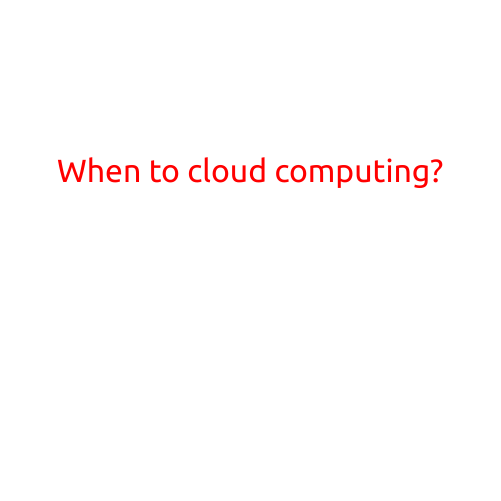
When to Cloud Computing?
Cloud computing has become an increasingly popular trend in the IT industry, offering numerous benefits such as scalability, flexibility, and cost-effectiveness. However, deciding when to adopt cloud computing is a crucial step that requires careful consideration of several factors. In this article, we’ll explore the situations where cloud computing makes the most sense and when it may not be the best choice.
1. When Your Business is Growing Rapidly
Cloud computing is ideal for businesses that are experiencing rapid growth. With cloud computing, you can scale your infrastructure up or down as needed, allowing you to quickly adapt to changing demands without the need for expensive hardware upgrades. This flexibility is particularly important for fast-growing startups and small businesses that require the ability to rapidly expand their IT infrastructure.
2. When You Need to Reduce Costs
Cloud computing can help reduce costs in several ways. By eliminating the need for on-premise hardware and software, you can minimize capital expenditures and reduce the cost of maintaining and upgrading IT infrastructure. Additionally, cloud computing providers often offer pay-per-use pricing models, which can help reduce costs by only paying for what you use.
3. When You Need to Improve Collaboration and Accessibility
Cloud computing enables employees to access applications and data from anywhere, at any time, on any device. This improves collaboration and productivity, particularly for distributed teams or businesses that require global access to resources. Cloud computing also provides a centralized platform for teams to share files, collaborate on projects, and communicate effectively.
4. When You Need to Ensure Business Continuity and Disaster Recovery
Cloud computing provides built-in disaster recovery and business continuity capabilities, which can help ensure that your business operations are not disrupted in the event of an outage or disaster. By storing data in a cloud-based infrastructure, you can ensure that your data is easily accessible and recoverable in the event of a disaster.
5. When You Need to Develop and Test Applications Quickly
Cloud computing provides a highly scalable and adaptable platform for developing and testing applications. With cloud computing, you can quickly spin up or down resources as needed, allowing developers to focus on writing code rather than managing infrastructure.
When Cloud Computing May Not Be the Best Choice:
1. For High-Security or Highly Regulated Industries
Cloud computing may not be the best choice for industries that require extremely high levels of security and compliance, such as government agencies, financial institutions, or healthcare organizations. These organizations often require a high degree of control over their IT infrastructure and may not be able to guarantee the same level of security and compliance in a cloud environment.
2. For Complex, Custom Applications
Cloud computing may not be suitable for complex, custom applications that require significant customization and control over the underlying infrastructure. In these cases, on-premise infrastructure may be more suitable, allowing for greater control over the application and infrastructure.
3. For Applications with High Latency Requirements
Cloud computing may not be the best choice for applications that require low latency, such as real-time applications or video editing software. In these cases, on-premise infrastructure may be more suitable, allowing for faster data transfer and processing times.
In conclusion, cloud computing is an attractive option for businesses that require scalability, flexibility, and cost-effectiveness. However, it’s essential to carefully consider your specific needs and requirements before deciding whether cloud computing is the right choice for your business. By weighing the benefits and drawbacks of cloud computing, you can make an informed decision that meets your unique needs and goals.





